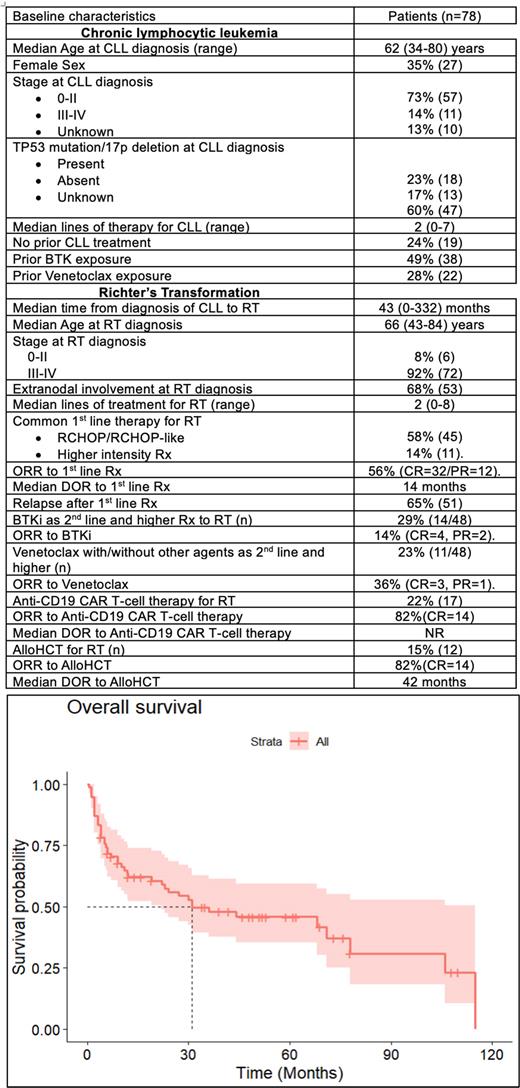INTRODUCTION:
Richter's transformation (RT) is the transformation of chronic lymphocytic leukemia or small lymphocytic lymphoma (CLL/SLL) into an aggressive lymphoma, most commonly diffuse large B-cell lymphoma (DLBCL). RT occurs in 2-10% of CLL patients, usually between 2-5 years after CLL diagnosis. The prognosis of RT is poor and the historical median overall survival (OS) after diagnosis is about 8-14 months. However, with the development of novel therapeutic agents including Bruton tyrosine kinase inhibitors (BTKi) and anti-CD19 CAR T-cell therapy, the natural history and prognosis of RT have evolved. To date there is limited data on the prognosis and management of RT in the era of novel therapies.
To better understand the prognosis, impact of new therapeutics, and survival for RT in the modern era we performed a multicenter retrospective study to assess the outcomes of RT.
METHODS:
We performed a multicenter retrospective study including 4 US centers evaluating patients who were diagnosed with RT between 2012-2022 with the current analysis limited to those patients with large B-cell lymphoma transformation. Statistical analyses include descriptive statistics, t-tests for normally distributed continuous variables, non-parametric tests for skewed variables, and chi-square for categorical variables. Overall survival (OS) was calculated using Kaplan-Meier estimates.
RESULTS:
We analyzed 78 patients with DLBCL transformation from underlying CLL. The median age at RT diagnosis was 66 years (43-84 years). Most patients had advanced stage III-IV disease 92% (n=72). Extranodal disease was present in 68% (n=53). Among 31 patients with 17p deletion or p53 mutational data available at the time of CLL diagnosis, one of these findings was present in 18 patients. Patients had 2 median lines (range 0-7) of treatment for CLL prior to RT diagnosis. 49% (n=38) had BTKi exposure and 28% (n=22) had Venetoclax exposure before RT diagnosis. 24% (n=19) had no prior treatment for CLL before RT.
The median time from CLL to RT diagnosis was 42.5 (0-332) months. Median lines of therapy for RT were 2 (range 1-8). The most common frontline regimens for RT included R-CHOP/ R-CHOP-like backbone in 58% (n=45) or high intensity chemoimmunotherapy regimens (R-EPOCH/CVAD) in 14% (n=11). Overall response rate (ORR) to frontline treatment was 56% (complete response (CR)=32/partial response (PR)=12). Of the patients who received 1 st line treatment and achieved a CR/PR (n=44), the 1-year duration of response (DOR) was 50% and the median DOR was 14 months. Fifty-one patients either relapsed or had refractory/progressive disease after frontline treatment and 48 patients received further treatment. Among these 48 patients, 29% (n=14) received a covalent or a non-covalent BTKi in the 2 nd or higher line setting, with an ORR of 43% (CR=4, PR=2). 23% (n=11) received venetoclax with/without other agents in the 2 nd or higher line setting, with an ORR of 36% (CR=3, PR=1).
In total, 17 patients received CD19 based CAR T-cell therapy as part of treatment for RT, all in a second or later line of treatment. The ORR and CR rate to this therapy was 82% (n=14). Of these 14 responding patients, the 1-year DOR was 57% and the median DOR was not reached.
12 patients underwent allogeneic transplant (alloHCT), 11/12 as a consolidative treatment option. At first disease assessment after allo-HCT, the ORR was 92% (CR=11). Of the 11 responders, the 1-year DOR was 73% and the median DOR was 42 months. For the entire cohort (n=78), the 1-year OS was 62% and the median OS was 31 months (95% CI 22-NR), which suggest improvement compared to historical reports.
CONCLUSION
Although RT has a poor prognosis, with the use of novel therapies such as BTKi and CAR T-cell therapy, the overall survival of these patients has improved in the current era. The overall response to chemoimmunotherapy in the first line setting remains poor. Despite this, advances in the management of RT with incorporation of targeted and cellular therapies has improved clinical outcomes of RT. Incorporating these agents either alone or in combination with chemoimmunotherapy in the earlier setting may further improve outcomes in patients with this aggressive disease.
Disclosures
Svoboda:Atara: Consultancy; Incyte: Consultancy, Research Funding; Astra Zeneca: Consultancy, Research Funding; BMS: Consultancy, Research Funding; Genmab: Consultancy; Adaptive: Consultancy, Research Funding; TG Therapeutics: Research Funding; ADCT: Consultancy; Merck: Research Funding; Pharmacyclics: Consultancy, Research Funding; SEAGEN: Consultancy, Research Funding. Hill:Kite, a Gilead Company: Consultancy, Honoraria, Other: travel support, Research Funding; Genentech: Consultancy, Other: Advisory board, Research Funding; Bristol Myers Squibb: Consultancy; BeiGene: Consultancy; AbbVie: Consultancy, Other: Advisory board, Research Funding; AstraZeneca: Consultancy; Pharmacyclics: Consultancy, Other: Advisory board, Research Funding; Incyte: Consultancy; Gilead: Other: Advisory board. Romancik:Astra Zeneca: Consultancy; KITE: Consultancy. Shah:Umoja: Consultancy; TG therapeutic: Consultancy; Abbvie: Consultancy; Gilead/Kite: Consultancy; Miltenyi Biotec: Consultancy, Other: Travel support, Research Funding; Lilly Oncology: Consultancy, Research Funding; Tundra Therapeutics: Current holder of stock options in a privately-held company; Incyte: Consultancy; Novartis: Consultancy; Janssen: Consultancy; Seattle Genetics: Consultancy; BMS/Juno: Consultancy; LOXO-Lilly: Consultancy, Other: Travel support; Epizyme: Consultancy.


This feature is available to Subscribers Only
Sign In or Create an Account Close Modal